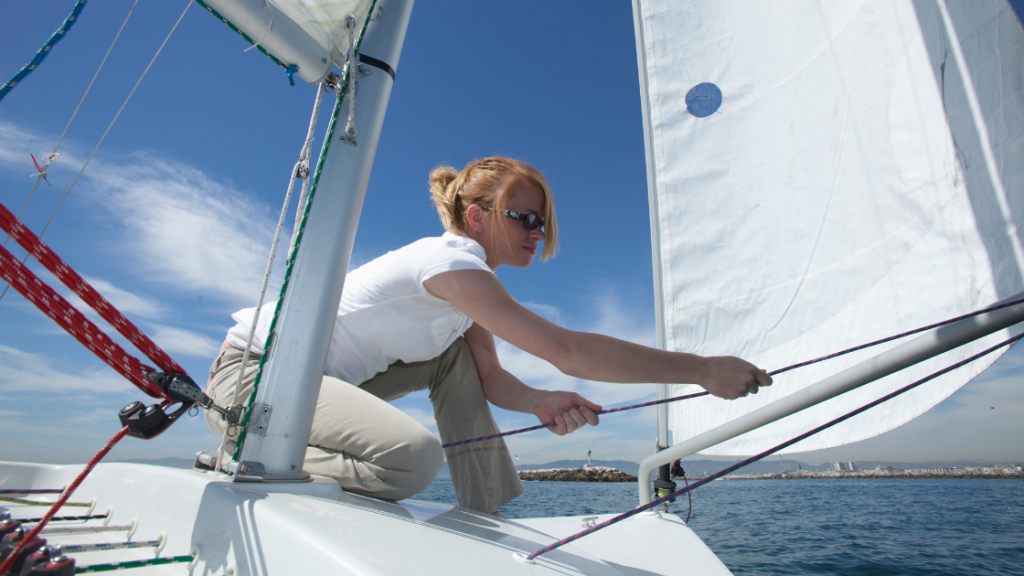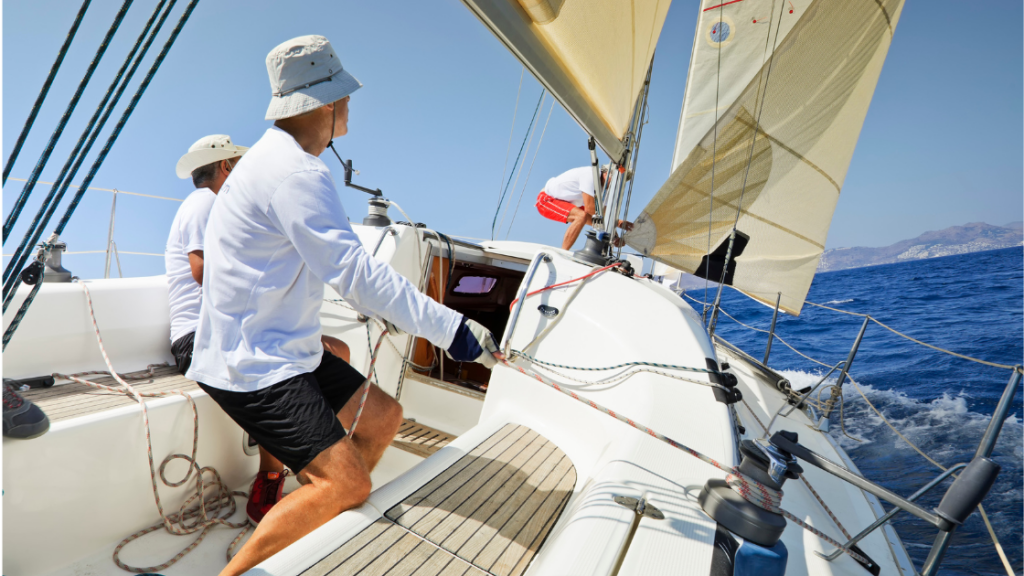Solo and Shorthanded Sailing: Gain Independence on the Water
July 2nd, 2025 by team

by B.J. Porter (Contributing Editor)
Years ago when we had a new-to-us boat and new-to-us children, my wife and I found ourselves in a quandary. How can we sail a boat that’s ten feet longer than our last with a toddler and a new baby to tend at the same time? We needed all hands to manage the boat and at least one to mind the kids.
We spent an entire season scrambling for “guests” to come on board, because we didn’t have the confidence to sail our boat and leave the children unattended. Sometimes we didn’t find someone, and we stayed home. We were new parents and pretty new sailors, and it wasn’t an excellent combination.
Had either of us been better or more confident sailors, this would have been much less of a problem. Had either of us known how to set and trim the sails, tack, gybe, and sail the boat single-handed, we would have spent a lot more weekends on the water.
Years later, we were crossing oceans with one of us on watch and everyone sleeping, setting and reefing sails, trimming, and steering all on our own. So what changed? We got to be better sailors, but more importantly, we learned a few things about solo boat handling that meant we could sail with just one of us.
So what does it take?
Learning Your Boat

The first step is to learn your boat and how it sails with more people than just you. You don’t need a racing crew of a dozen, but two people should be able to handle most boats under forty feet pretty easily. With some help, you can handle something even larger.
But you need to be comfortable setting and dousing all your sails without incident, as well as handling the boat in close quarters to pick up moorings or get into slips. It’s good for single handing (and many other reasons) to be proficient reefing your sails. A de-powered boat is always easier to handle. Even if you’re not screaming along at hull speed, you’ll want the boat in control for single handing.
If you can’t confidently sail your boat with one or two other people, you will struggle to do it by yourself.
Planning Your Moves

The big trick to single-handed maneuvers is thinking them through ahead of time. To do something like tack the boat, there are several steps you need to take, and you need to do them in the right order.
That means you need to have a plan for how you do every maneuver before you start until you’ve got them down cold. For tacking, you’ve got to get the helm over at the right time while you’re breaking one side and bringing in the sail on the other side. You can’t mis-step.
So consider everything you need to do, break it down into steps, and commit them to memory and practice them.
Taking it Slow
There’s no need to rush most maneuvers. Suppose you back wind the job in the middle of a tack…then so what? Worst-case scenario, you put yourself in irons. Who’s watching?
A few years back, I had to get my boat to a regatta, and couldn’t get anyone to help with the mid-week delivery. It turned out to be a gorgeous day, with perfect sailing conditions. I just had to sail it myself for the first time. And I did – I got the main up, the jib out, and started barreling down Narragansett Bay towards Newport.
As I got close, I came up on one of the twelve meter yachts that run out of Newport. And I needed to tack. I was like, “oh my goodness, there’s a twelve meter America’s Cup winner with a pro crew right there and I’m going to flub this tack.” I got really nervous. I felt like a kid going up to the board to solve a problem in class who just realized he had to use the bathroom. Then I stopped and thought about what I was doing.
They had ten or twelve people on board, several of them professional sailors. But here I was, on my forty-foot race boat, and I was sailing it by myself to a weekend regatta. Who cares if I made a mess of the tack in front of anyone? I was single-handing my boat, dang it!
So I tacked. It was slow, and it probably wasn’t pretty. But it didn’t matter…I waved at that pretty piece of history as I sailed by, and a few of them waved back. But nobody pointed and laughed.
Don’t stress it, don’t rush it – it’s better to make a mistake or go slow than to rush it and break something or find yourself stuck with a winch override.
Intermediate Steps
Part of the planning is figuring out intermediate steps to make your solo actions easier. For example, jibing your boat with several other people is pretty easy. Someone can manage the main, break the jib, and haul in on the other side while you slowly turn through the wind.
But by yourself? A few extra steps can make it much easier. For that jibe, if you center up the main first, then all you have to deal with is the jib. It’s no big deal if you take a few minutes to ease the main back out after you settle in. While you’re at it, take a moment to pre-load the lazy sheet, so you’re ready to haul the sail in.
Break every action down, and look for places where you can pause, free up a hand, and make the next step easier.
Sail and boat handling help

There are both hardware solutions and techniques to help you with shorthanded sailing. Getting your gear in control makes it easier, so things like self-tacking jibs and furlers will never hurt.
Furlers
Furlers are a big win for short handed sailing, letting you deal with the sails without leaving the cockpit if they’re run well. It’s a little different with one person because you need to hold the boat on a good wind angle while handling two lines, but it’s much easier than running up to haul on a halyard or fool around with hanks.
Cross-sheeting
Controlling your sails by yourself while driving the boat can be a challenge. On that race boat delivery, for visibility I drove from the high side when sailing upwind. But the jib sheet was on the leeward side, way down out of my reach. The solution? I ran the sheet around the leeward primary winch, then across the cockpit to the windward winch. From there I could put it in the self tailer and ease or trim the sail along with the main (which I could reach) while driving the boat from the best spot.
Check the angles on your winches, because this technique can move lines which are out of reach right back to the helm if you’re clever.
Autopilots and Wheel Brakes
A functioning autopilot makes all the difference. A smart one can keep you on the same wind angle, but even an old, simple system can hold you in a straight line while you point the boat to windward to hoist sails.
While sailing, the autopilot is an extra pair of hands, and when you’re comfortable with it, you can do all your trimming and handling more easily.
If you don’t have an autopilot, a wheel brake can be an extra set of hands in a pinch. It can, for a short while, keep the boat going in the right direction while you do what you need to. There are a few things to watch out for, though.
- Make sure your wheel brake can take the load. Wheel brakes are primarly for holding the rudder from flopping around at anchor, not sailing the boat, and some are not that strong.
- Center the rudder before you apply the brake, otherwise it won’t go straight!
- Don’t leave the brake on for long. It’s not intended to sail the boat like an autopilot. But it can buy you some critical time.
Lazyjacks and other sail handlers
Without help, getting sails down can be harder than putting them up. A mainsheet spilled all over the deck while you’re on the boat by yourself takes a while to sort. But there are many good upgrades to tame the main when it comes down if you don’t want a furler. If you don’t have them, explore systems like lazyjacks, Dutchman, or stack packs so you can just dump the main to a neat little pile.
And if you have a sail handling system on board already, learn how to use it solo as soon as you can!
Practice…always practice!

Like almost everything in sailing, it always comes down to practicing to learn the skills. Do it, learn it, then do it again.
If you regularly sail with a partner or crew, take turns soloing the boat while they’re on board. It’s easy to just have the other person sit back and do nothing while you practice. Then do the same for them.
The more you can do by yourself – even if you never actually sail alone – the better sailor you will be. Those skills give you more options to go out of the marina and go places.
- Posted in Blog, Boat Care, Boating Tips, Cruising, iNavX, Navigation, News, Reviews, Sailing, Sailing Tips
- No Comments
- Tags: shorthanded sailing, singe handed sailing, solo sailing


Leave a Reply